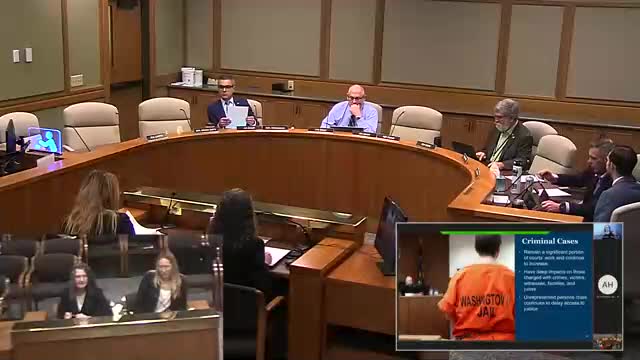Judicial System struggles with rising case backlog amid unrepresented defendant crisis
February 25, 2025 | Public Safety, Ways and Means, Joint, Committees, Legislative, Oregon
This article was created by AI summarizing key points discussed. AI makes mistakes, so for full details and context, please refer to the video of the full meeting. Please report any errors so we can fix them. Report an error »

The Joint Committee on Ways and Means Subcommittee on Public Safety convened on February 25, 2025, to address pressing issues within Oregon's judicial system, particularly the ongoing public defense crisis and its impact on case resolution times.
The meeting began with a discussion on the significant increase in criminal case filings projected by the Office of Economic Analysis, forecasting a 34.4% rise in misdemeanor cases and an 8.4% rise in felony cases over the next biennium. This uptick in filings exacerbates existing delays in case resolutions, contributing to a growing backlog within the judicial system.
House Bill 4,002, passed in the previous session, was highlighted as a contributing factor to the increased workload for courts. This legislation recriminalizes possession of controlled substances and mandates new procedures for record sealing and conditional discharges. The subcommittee expressed concerns that without adequate funding and infrastructure, courts would struggle to meet the demands imposed by this legislation.
The discussion then shifted to clearance rates for cases. While felony cases maintained a clearance rate of 97% in 2024, misdemeanor cases fell short of the 98% goal, achieving only 90%. The subcommittee noted that the unrepresented crisis—where defendants lack legal representation—significantly prolongs case resolution times, as these cases remain open longer while awaiting attorney appointments.
The time to disposition for criminal cases also fell below established goals, with only 85% of felony cases resolved within the target of 365 days and 79% of misdemeanor cases within 180 days. The subcommittee emphasized the human cost of these delays, affecting defendants, victims, and witnesses alike, as unresolved cases create uncertainty and hinder individuals' ability to move forward with their lives.
In response to the unrepresented crisis, the court system has implemented various measures, including data entry assistance, communication with unrepresented individuals, and prioritizing cases for attorney appointments. The subcommittee acknowledged the challenges in managing unrepresented cases, which consume significant court resources and hinder overall efficiency.
The meeting concluded with a call for continued collaboration among stakeholders to develop jurisdiction-specific plans aimed at improving case processing efficiency. The subcommittee recognized the cyclical nature of the unrepresented crisis and the need for legislative support to enhance court operations and expedite case resolutions.
Overall, the discussions underscored the urgent need for systemic improvements within Oregon's judicial system to address the growing public defense crisis and its implications for timely case resolution.
The meeting began with a discussion on the significant increase in criminal case filings projected by the Office of Economic Analysis, forecasting a 34.4% rise in misdemeanor cases and an 8.4% rise in felony cases over the next biennium. This uptick in filings exacerbates existing delays in case resolutions, contributing to a growing backlog within the judicial system.
House Bill 4,002, passed in the previous session, was highlighted as a contributing factor to the increased workload for courts. This legislation recriminalizes possession of controlled substances and mandates new procedures for record sealing and conditional discharges. The subcommittee expressed concerns that without adequate funding and infrastructure, courts would struggle to meet the demands imposed by this legislation.
The discussion then shifted to clearance rates for cases. While felony cases maintained a clearance rate of 97% in 2024, misdemeanor cases fell short of the 98% goal, achieving only 90%. The subcommittee noted that the unrepresented crisis—where defendants lack legal representation—significantly prolongs case resolution times, as these cases remain open longer while awaiting attorney appointments.
The time to disposition for criminal cases also fell below established goals, with only 85% of felony cases resolved within the target of 365 days and 79% of misdemeanor cases within 180 days. The subcommittee emphasized the human cost of these delays, affecting defendants, victims, and witnesses alike, as unresolved cases create uncertainty and hinder individuals' ability to move forward with their lives.
In response to the unrepresented crisis, the court system has implemented various measures, including data entry assistance, communication with unrepresented individuals, and prioritizing cases for attorney appointments. The subcommittee acknowledged the challenges in managing unrepresented cases, which consume significant court resources and hinder overall efficiency.
The meeting concluded with a call for continued collaboration among stakeholders to develop jurisdiction-specific plans aimed at improving case processing efficiency. The subcommittee recognized the cyclical nature of the unrepresented crisis and the need for legislative support to enhance court operations and expedite case resolutions.
Overall, the discussions underscored the urgent need for systemic improvements within Oregon's judicial system to address the growing public defense crisis and its implications for timely case resolution.
View full meeting
This article is based on a recent meeting—watch the full video and explore the complete transcript for deeper insights into the discussion.
View full meeting
